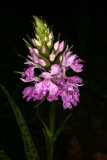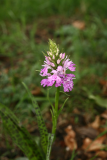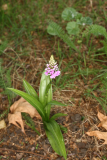Additional notes (click to expand)
Medicinal
It is difficult to know which of the orchids in Gerard's Herball is specifically Dactylorhiza maculata, but he calls all the plants with palmate roots 'Satyrions' (and some members of the genus Ophrys, which do not). However D. maculata may be one of his 'Satyrion Royall', for which he gives the uses: 'The roots of Satyrion royall are like to Cynosorchis of Dogs stones, both in savour and taste, and therefore are thought by some to be of like faculties. Yet Nicholaus Nicolus, in the chapter of the cure of the Quartain Ague, saith, that the roots of 'Palma Christi' [orchids with palmate roots] are of a force to purge upward [vomit] and downward [diarrhoea]; and that a piece of root as long as ones thumbe stamped and given with wine before the fit [episode of fever] commeth, is a good remedie against old Quartaines [fevers with a four day cycle] after purgation; and reporteth that one, Baliolus, after he had endured 44 fits, was cured therewith'. This paragraph in the Herball is followed by a footnote which says that the author thinks that Nicholas Nicolus is referring to the other plant called 'Palma Christi' - Ricinus communis - as it is not possible to have a root of this orchid as long as ones thumb, and Ricinus is well known to cause diarrhoea and vomiting. HFO Note: In modern times it is used to make Salep.
Gerard, J. (1975). The Herbal or General History of Plants. New York: Fascimile Dover Publications Inc . p.221
Geographical distribution
- Africa, Northern Africa, Algeria
- Africa, Northern Africa, Morocco
- Asia-Temperate, Siberia
- Europe
Dactylorhiza maculata (L.)Soó
Family: ORCHIDACEAEGenus: Dactylorhiza
Species: maculata (L.)Soó
Common names: Heath Spotted Orchid
Pharmacopoeia Londinensis name: Satyrion
Distribution summary: N.W.Africa, Europe to C. Siberia
Habit: Perennial
Hardiness: H5 - Hardy; cold winter
Habitat: Acidic soils, heathland, moorland
Garden status: Not currently grown
Flowering months: June, July, August
Reason for growing: Medicinal





